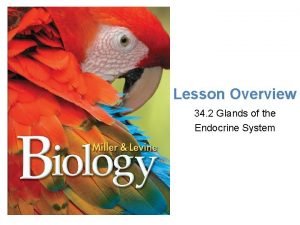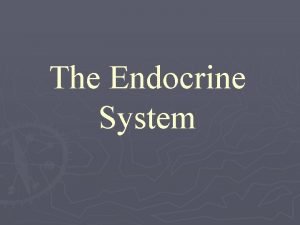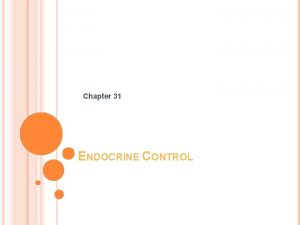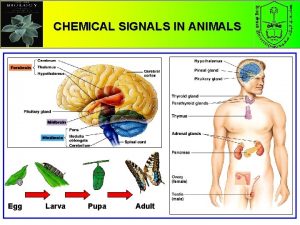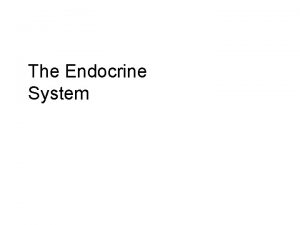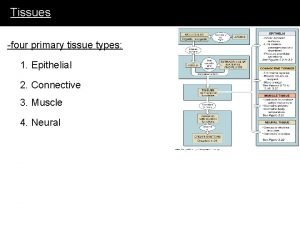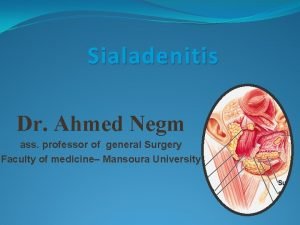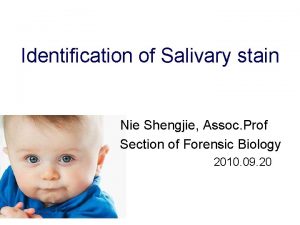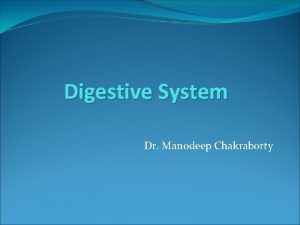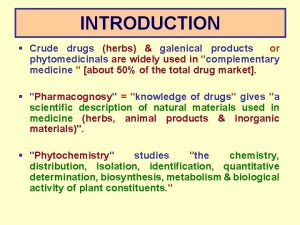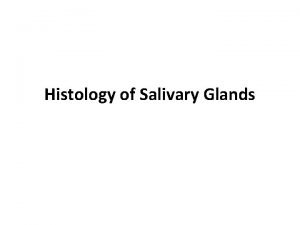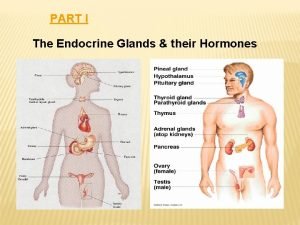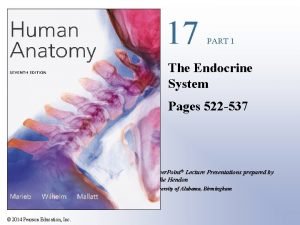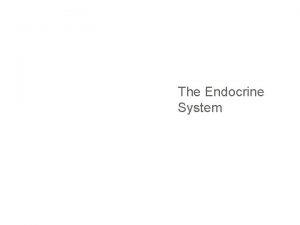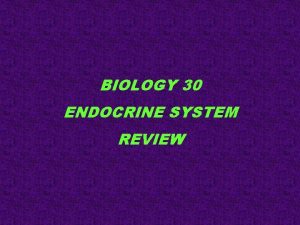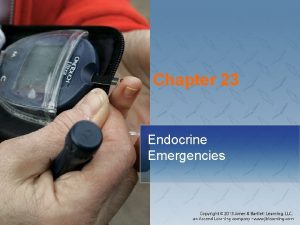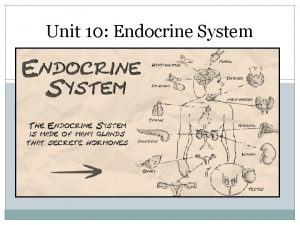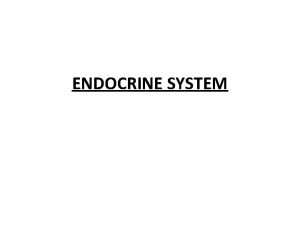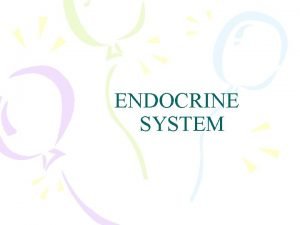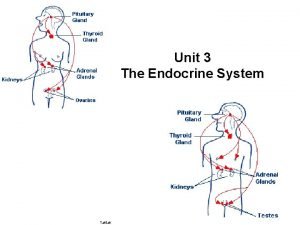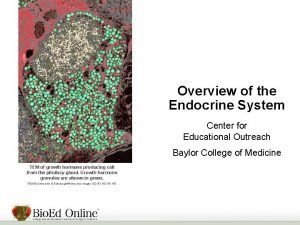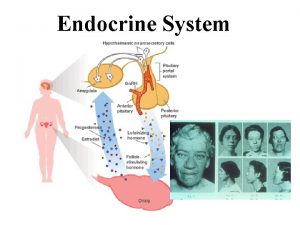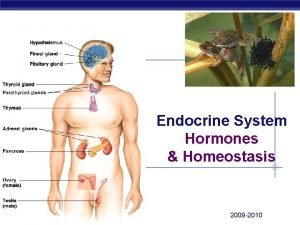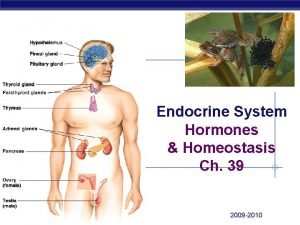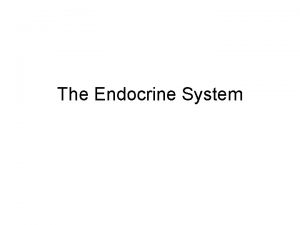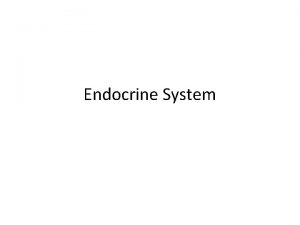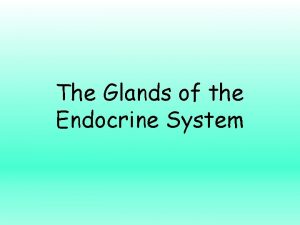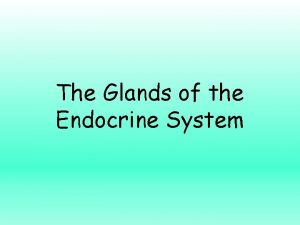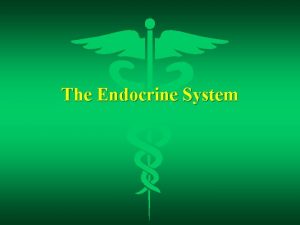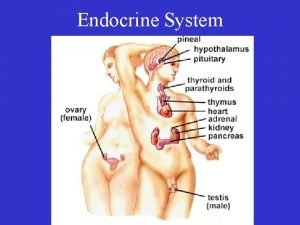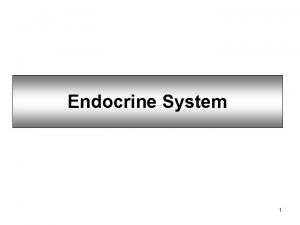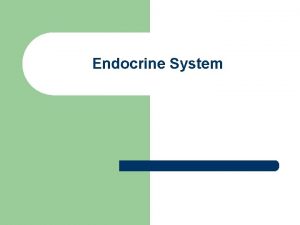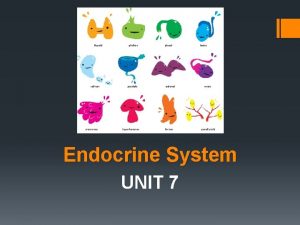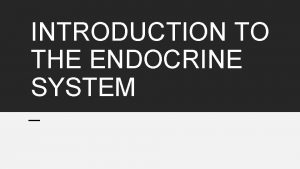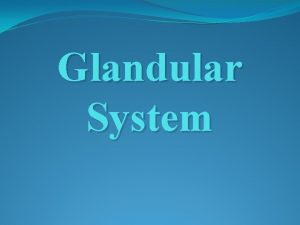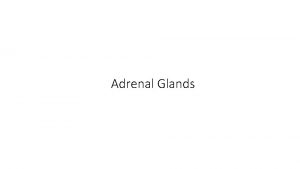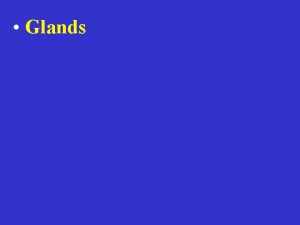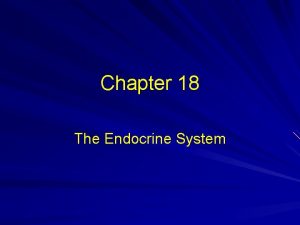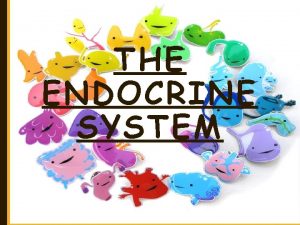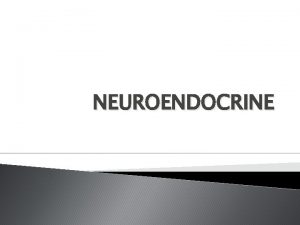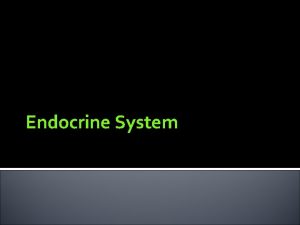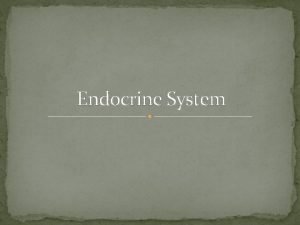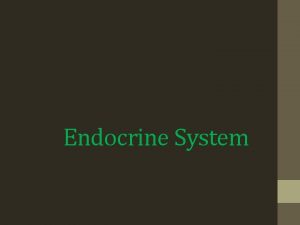Endocrine System A 2 types of glands in
















































- Slides: 48

Endocrine System A. 2 types of glands in the body 1. Exocrine – secrete their products into ducts A) Ex. sweat & salivary 2. Endocrine – secrete their products into blood or surrounding fluid A) Usually carried to target cells in other parts of the body

Endocrine System B. Hormones 1. Classification of Hormones A) Localized hormones – act locally without entering the bloodstream 1) Paracrine a) Carry out actions on other cells in the immediate area b) Ex. prostaglandins

Endocrine System 2) Autocrine a) Carry out actions on the cells releasing them b) Ex. nitric oxide B) Circulating hormones (endocrines) – enter the bloodstream and act on distant cells

Endocrine System 2. Chemical Nature of Hormones A) Amino-acid based hormones – the majority of hormones; water-soluble 1) Amines a) Simple hormones derived from the amino acid tyrosine (ex. epinephrine) 2) Peptides and proteins a) Chains of amino acids (ex. oxytocin)

Endocrine System B) Steroid-based hormones 1) Lipid-soluble hormones derived from cholesterol (ex. testosterone & estrogen) C) Eicosanoids 1) Hormone-like substances derived from arachidonic acid which act only on cells in their immediate vicinity (ex. prostaglandins & leukotrienes)

Endocrine System 3. Mechanism A) Release stimulated by the nervous system, other hormones, or other physiological factors B) May act in immediate area but usually transported in blood to target cells C) Alter the cellular activity of target cell to achieve physiological response

Endocrine System 1) Typical physiological responses a) Open/close membrane ion channels to alter membrane permeability or potential b) Stimulate/inhibit synthesis of proteins c) Activate/deactivate enzymes d) Induce/block secretion of cellular products e) Stimulate/inhibit mitosis or meiosis

Endocrine System 4. Transport A) Water-soluble hormones 1) Flow freely in blood B) Lipid-soluble hormones 1) Attach to a transport protein 2) Must detach to carry out action

Endocrine System 5. Method of Action A) Water-soluble hormones 1) Usually work via a second messenger system 2) 2 main second messenger systems a) Cyclic AMP (c. AMP) Signaling Mechanism i) The hormone binds to a receptor on the target cell’s membrane

Endocrine System ii) The bound receptor changes shape activating a nearby G protein iii) The activated G protein activates adenylate cyclase (a membrane enzyme) (a) This inactivates the G protein iv) Adenylate cyclase will stimulate the production of c. AMP within the target cell v) c. AMP activates protein kinase A within the cell

Endocrine System vi) Protein kinase A phosphorylates other enzymes within the target cell causing the physiological response (a) Activates some enzymes & inhibits others vii) Phosphodiesterase degrades c. AMP thereby stopping its action


Endocrine System b) PIP-Calcium Signal Mechanism i) The hormone binds to a receptor on the target cell’s membrane ii) The bound receptor changes shape activating a nearby G protein iii) The activated G protein activates phospholipase C (a membrane enzyme) (a) This again inactivates the G protein

Endocrine System iv) Phospholipase C splits PIP 2 (phosphatidylinositol 4, 5 -bisphosphate) into DAG (diacylgycerol) & IP 3 (triphosphoinositol) v) DAG activates protein kinase C causing a physiological response vi) IP 3 causes the release of Ca++ from the endoplasmic reticulum (a) This amplifies the physiological response



Endocrine System B) Lipid-soluble hormones 1) Diffuse directly through the target cell’s membrane 2) Bind to receptors in cytoplasm or nucleus a) Translocation 3) Turns on/off gene transcription of the cell’s DNA 4) Causes the production of a new protein by the cell or stops the production of an already present protein 5) Causes physiological response



Endocrine System 6. Feedback Systems A) Negative feedback system 1) Physiological response causes decreased release of the hormone B) Positive feedback system 1) Physiological response causes increased release of the hormone

Endocrine System 7. Responsiveness of Target Cell A) Dependent on 4 factors 1) Blood levels of the hormone 2) Abundance of receptors on the target cell a) Some cells have the ability to produce more receptors when blood hormone levels are high = upregulation

Endocrine System b) Others cells lose receptors in response to prolonged exposure to a hormone = downregulation 3) Affinity of the bond between hormone and receptor a) Affinity can also be influenced by blood levels of a particular hormone 4) Interaction with other hormones

Endocrine System a) Permissive interaction i) Hormone requires current or recent exposure to another hormone (a) Reproductive hormones require the presence of thyroid hormones to work properly b) Synergistic interaction i) 2 hormones together cause a stronger response than their individual responses combined

Endocrine System (a) Glucagon and epinephrine both increase blood glucose individually; when working together blood glucose levels increase 150% more than if each hormone worked alone c) Antagonistic interaction i) One hormone inhibits the response of another (a) Glucagon inhibits the action of insulin

Endocrine System C. Glands 1. Pituitary (Hypophysis) A) Attached directly to the hypothalamus via the infundibulum B) Subdivided into 2 lobes 1) Anterior (adenohypophysis) a) Human growth hormone (HGH) i) Stimulates cell growth & protein synthesis

Endocrine System b) Thyroid stimulating hormone (TSH) i) Stimulates production of T 3 & T 4 c) Follicle stimulating hormone (FSH) i) Females (a) Stimulates follicle development & release of estrogen ii) Males (a) Stimulates sperm production

Endocrine System d) Luteinizing hormone (LH) i) Females (a) Stimulates follicle development & ovulation ii) Males (a) Stimulates testicular development & release of testosterone e) Prolactin (PRL) i) Initiates & maintains milk production

Endocrine System 2) Posterior (neurohypophysis) a) Oxytocin (OT) i) Enhances labor & stimulates milk production b) Antidiuretic hormone (ADH) i) Increases water reabsorption in the kidneys (DCT & CD)

Endocrine System 2. Thyroid A) Follicular cells 1) T 3 (triiodothyronine) & T 4 (thyroxine) a) Regulate cellular metabolism, growth & development

Endocrine System B) Parafollicular cells 1) Calcitonin (CT) a) Decreases blood Ca++ levels by increasing osteoblast activity

Endocrine System 3. Parathyroid A) Parathyroid hormone (PTH) 1) Increases blood Ca++ by increasing osteoclast activity 4. Adrenal Glands A) Adrenal cortex 1) Aldosterone a) Promotes Na+ reabsorption in the kidneys (DCT & CD)

Endocrine System 2) Androgens a) Considered a male sex hormone although its produced by both sexes b) Effects are generally not seen in males due to the presence of testosterone c) In females, it is responsible for skeletal changes seen with puberty, body hair growth, and libido

Endocrine System 3) Cortisol (hydrocortisone) a) Regulates one’s resistance to stress b) Depression of immune responses c) Anti-inflammatory agent B) Adrenal medulla 1) Epinephrine & norepinephrine a) Same functions as norepinephrine in sympathetic NS

Endocrine System 5. Pancreas A) Primarily composed of aciner cells 1) Produce pancreatic juice (enzymes) B) Scattered among the aciner cells are about one million islets of Langerhans (pancreatic islets)

Endocrine System 1) Composed of 4 hormone-producing cell types a) Alpha cells i) Glucagon (a) Increases blood glucose (sugar) b) Beta cells i) Insulin (a) Decreases blood glucose (sugar)

Endocrine System c) Delta cells i) Somatostatin (a) Inhibits release of insulin & glucagon d) F cells (PP cells) i) Pancreatic polypeptide (a) Inhibits secretion of somatostatin (b) May play a role in regulating appetite

Endocrine System 6. Gonads A) Ovaries 1) Progesterone & estrogen a) Regulate reproductive cycle b) Prepares body for pregnancy c) Stimulates development of secondary sex characteristics

Endocrine System 2) Inhibin a) Inhibits FSH 3) Relaxin a) Relaxes cervix during labor and delivery

Endocrine System B) Testes – interstitial cells 1) Testosterone a) Promotes spermatogenesis b) Stimulates development of secondary sex characteristics 2) Inhibin a) Inhibit FSH

Endocrine System 7. Pineal Gland A) Melatonin 1) Promotes sleepiness a) Its release is inhibited by light 8. Placenta A) Human chorionic gonadotropin (HCG) 1) Stimulates ovary to produce estrogen & progesterone to maintain pregnancy

Endocrine System 2) Detected by home pregnancy tests B) Estrogen & progesterone 1) Maintain pregnancy until mother’s hormones take over C) Human chorionic somatostatin 1) Stimulates development of mammary glands for lactation D) Relaxin 1) Relaxes cervix during labor & delivery

Endocrine System 9. Other endocrine organs A) Heart 1) Atrial natriuretic peptide (ANP) a) Decreases total blood volume by decreasing Na+ reabsorption in the kidneys (DCT & CD)

Endocrine System B) Kidney 1) Renin – from the JGA a) Increases total blood volume by stimulating the angiotensin-aldosterone mechanism 2) Erythropoietin (EPO) a) Increases RBC production

Endocrine System D. Disorders of the Endocrine System 1. Goiter – an enlarged thyroid gland; many causes but can be linked to a lack of iodine 2. Grave’s disease – autoimmune disorder resulting in hyperthyroidism and an enlarged thyroid gland 3. Addison’s disease – hyposecretion of cortisol due to progressive destruction of the adrenal cortex

Endocrine System 4. Cushing’s syndrome – hypersecretion of cortisol; causes a breakdown of muscle and a redistribution of body fat A) Characterized by a rounded “moon face” and a “buffalo hump” on the back 5. Diabetes insipidus – caused by an inability to secrete or respond to ADH; causes excess urine production, dehydration, and thirst

Endocrine System 6. Diabetes mellitus – the most common endocrine disorder A) A group of disorders caused by an inability of the body to produce or use insulin resulting in increased blood glucose; characterized by polyuria (excessive urine production), polydipsia (excessive thirst), and polyphagia (excessive hunger) B) 2 main types

Endocrine System 1) Type I diabetes (insulin-dependent diabetes mellitus) a) Caused by a deficiency of insulin b) Autoimmune disease characterized by the destruction of beta cells c) Patients are dependent on insulin injections throughout their life

Endocrine System 2) Type II diabetes (non-insulin-dependent diabetes mellitus) a) Patients have normal insulin levels but target cells are desensitized due to downregulation b) Most common type; linked to obesity c) Often controlled by diet, exercise, and weight loss
 Glands of the endocrine system
Glands of the endocrine system Epithelia
Epithelia Major endocrine glands male and female
Major endocrine glands male and female Endocrine
Endocrine Difference between endocrine and exocrine glands
Difference between endocrine and exocrine glands Are endocrine glands ductless
Are endocrine glands ductless Endocrine glands
Endocrine glands Whats the difference between endocrine and exocrine glands
Whats the difference between endocrine and exocrine glands Hypothal
Hypothal Endocrine glands
Endocrine glands What are chemical signals
What are chemical signals Endocrine system
Endocrine system Hyophysis
Hyophysis Rat dissection
Rat dissection Endocrine system and reproductive system
Endocrine system and reproductive system Endocrine system and nervous system
Endocrine system and nervous system Lymphatic system vs endocrine system
Lymphatic system vs endocrine system Mechanism of hormone action
Mechanism of hormone action Adh function
Adh function Tissue
Tissue Types of salivary glands
Types of salivary glands Types of salivary glands
Types of salivary glands Types of salivary glands
Types of salivary glands Enfleurage method ppt
Enfleurage method ppt Simple acinar gland histology
Simple acinar gland histology Epidermis
Epidermis Parts of the endocrine system
Parts of the endocrine system Differences between nervous system and endocrine
Differences between nervous system and endocrine Comparison of endocrine and nervous system
Comparison of endocrine and nervous system Endocrine molecules
Endocrine molecules Facts about the endocrine system
Facts about the endocrine system Calcitonin and pth are antagonistic hormones
Calcitonin and pth are antagonistic hormones Humoral neural and hormonal stimuli
Humoral neural and hormonal stimuli Chapter 7:13 endocrine system
Chapter 7:13 endocrine system Mammillary body
Mammillary body Figure of endocrine system
Figure of endocrine system Biology 30 endocrine system
Biology 30 endocrine system Adrenal nervous system
Adrenal nervous system Chapter 23 the endocrine system
Chapter 23 the endocrine system Endocrine system analogy
Endocrine system analogy The endocrine system consists of
The endocrine system consists of Endocrine system abbreviations
Endocrine system abbreviations T3.taktak
T3.taktak Classification of hormone
Classification of hormone Pancreas in endocrine system
Pancreas in endocrine system Endocrine system
Endocrine system Chapter 16 lesson 2 the male reproductive system
Chapter 16 lesson 2 the male reproductive system Endocrine system regents questions
Endocrine system regents questions Endocrine system regents questions
Endocrine system regents questions
